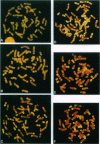Abstract
The human genome is made up of long DNA segments, the isochores, which are compositionally homogeneous and can be subdivided into a small number of families characterized by different G+C levels. Chromosome in situ suppression hybridization (in which excess unlabeled human DNA is added to suppress hybridization of repeated sequences present in the probe, enabling enhanced observation of single-copy sequences) of DNA fractions characterized by an increasing G+C level was carried out to determine the distribution of "single-copy" sequences corresponding to isochore families L1+L2, H1, H2, and H3 on metaphase chromosomes. This produced a banding pattern progressing from a relatively diffuse staining to an R-banding, to a T-banding. More specifically, our results showed that (i) T-bands are formed by the G+C-richest isochores of the H3 family and by part of the G+C-rich isochores of the H1 and H2 families (with a predominance of the latter); (ii) R'-bands (namely, R-bands exclusive of T-bands) are formed to almost equal extents by G+C-rich isochores of the H1 families (with a minor contribution of the H2 and H3 families) and by G+C-poor isochores of the L1+L2 families; (iii) G-bands essentially consist of G+C-poor isochores from the L1+L2 families, with a minor contribution of isochores from the H1 family. These results not only clarify the correlations between DNA base composition and chromosomal bands but also provide information on the distribution of genes in chromosomes, gene concentration increasing with the G+C levels of isochores.
Full text
PDF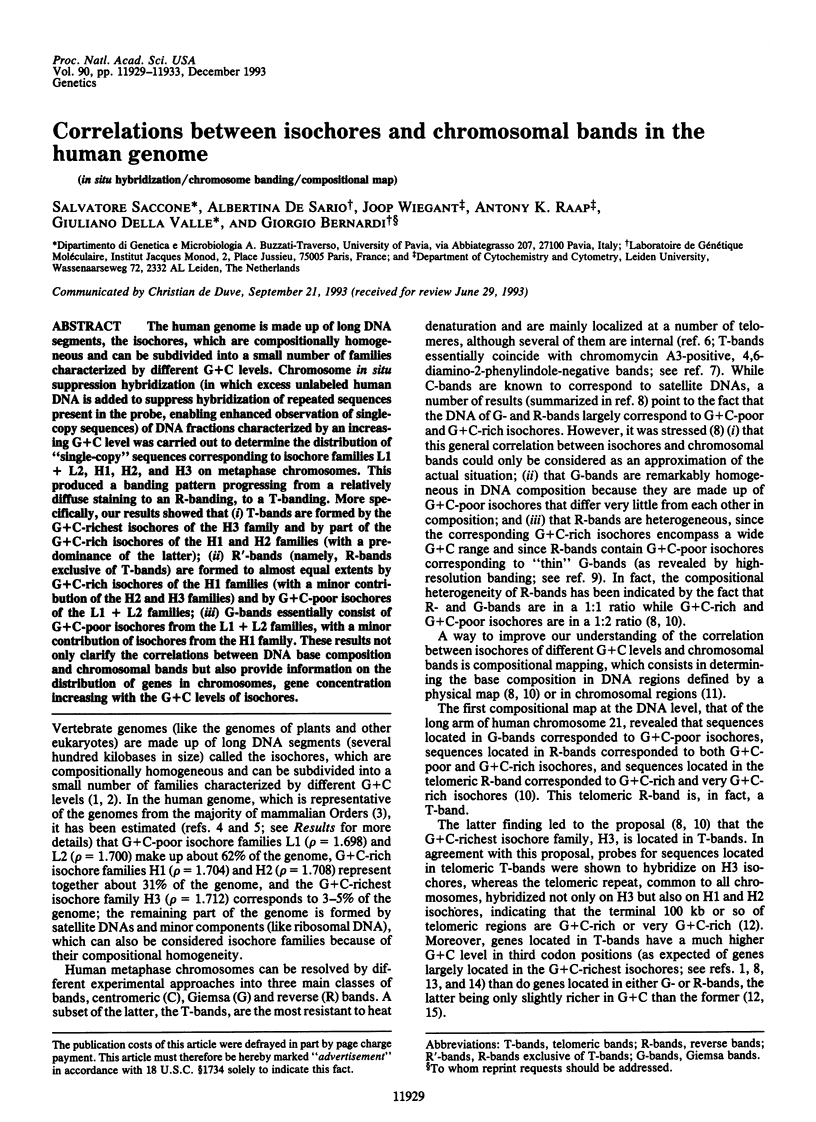
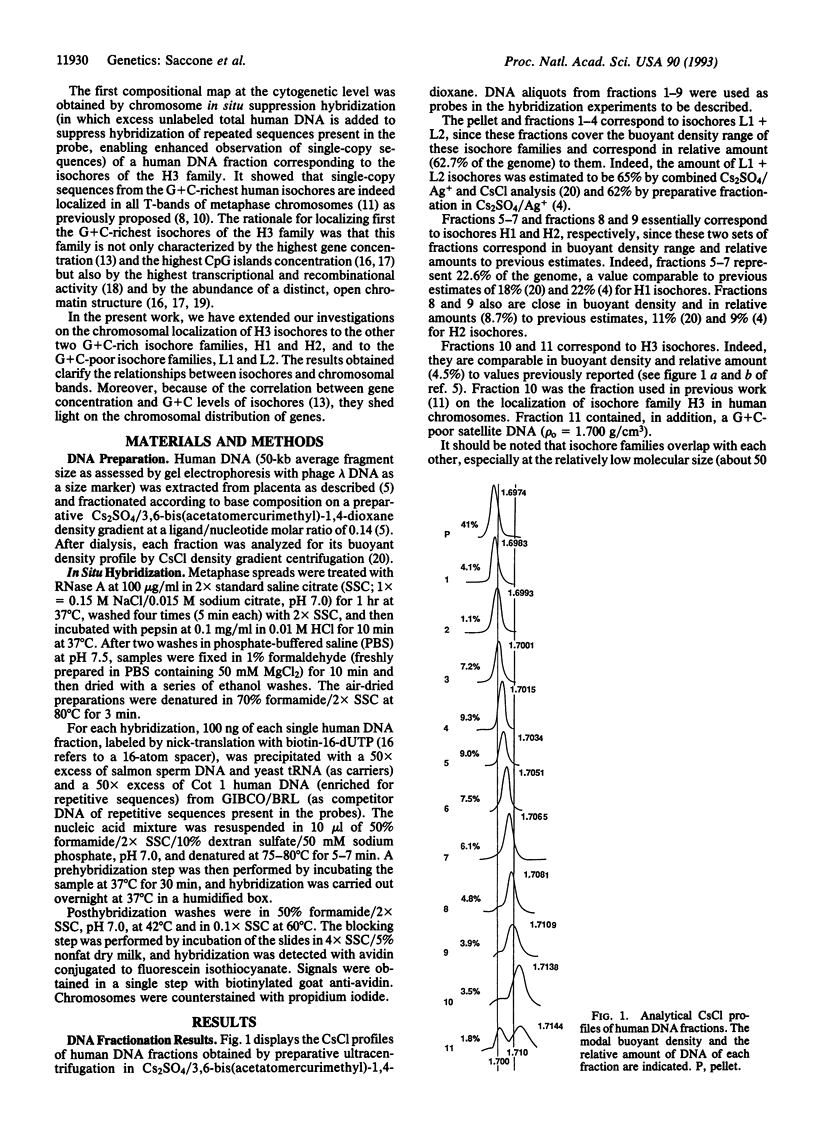
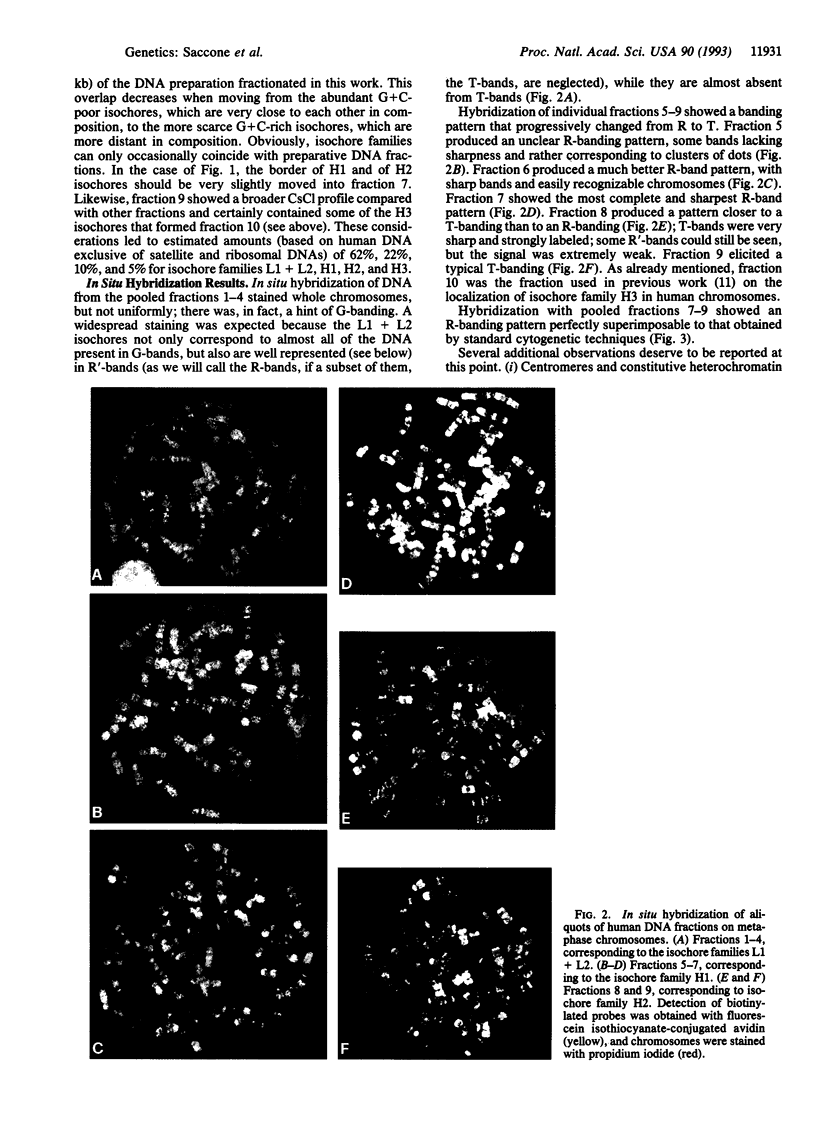
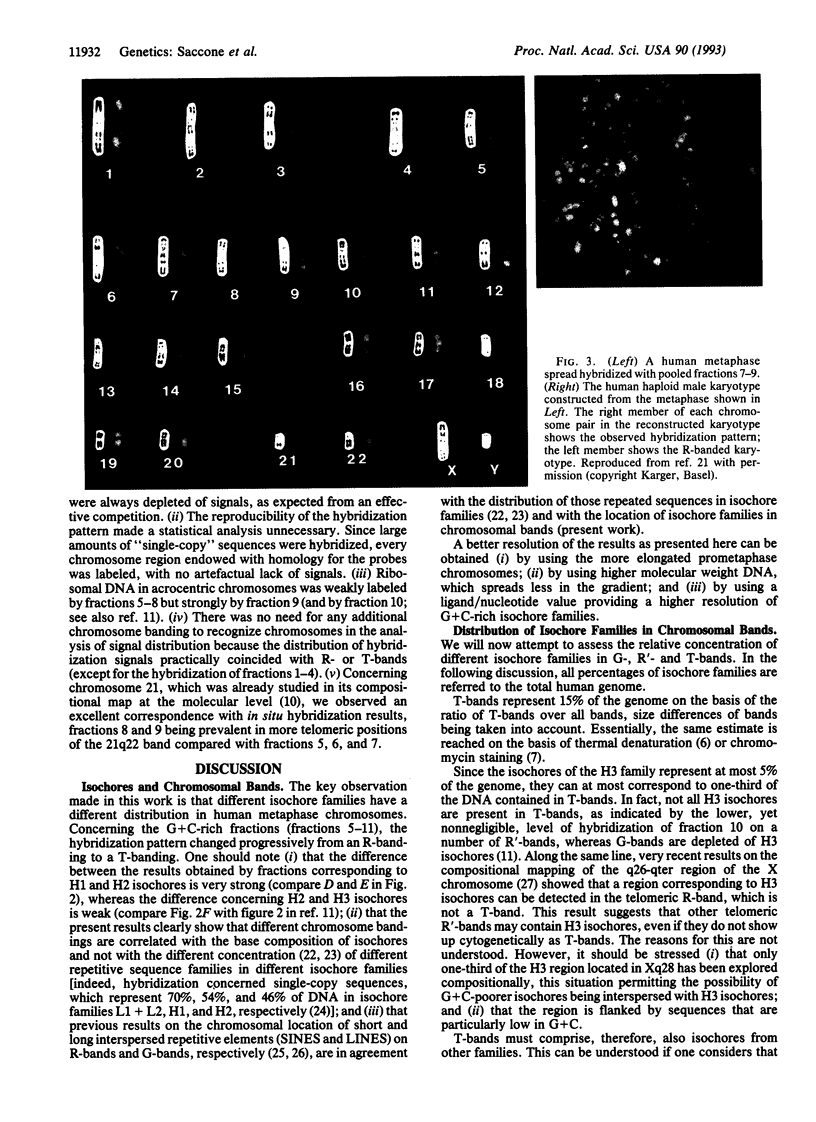
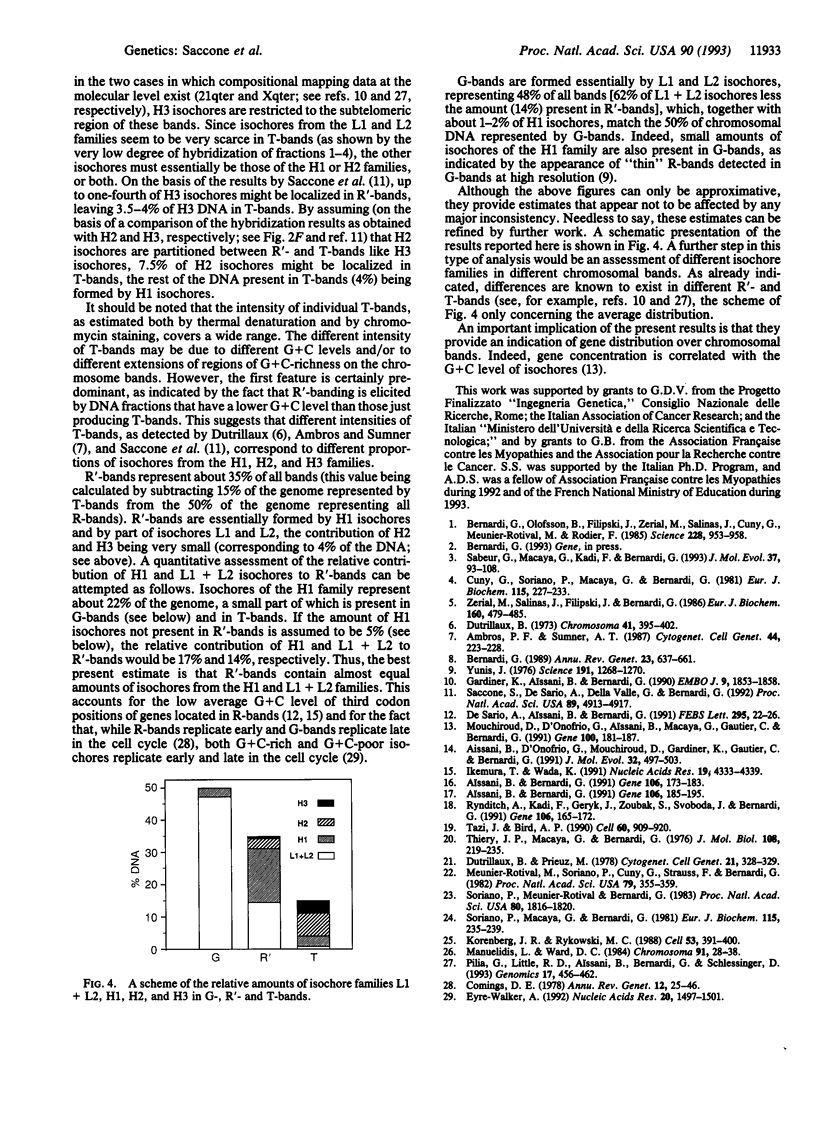
Images in this article
Selected References
These references are in PubMed. This may not be the complete list of references from this article.
- Ambros P. F., Sumner A. T. Correlation of pachytene chromomeres and metaphase bands of human chromosomes, and distinctive properties of telomeric regions. Cytogenet Cell Genet. 1987;44(4):223–228. doi: 10.1159/000132375. [DOI] [PubMed] [Google Scholar]
- Bernardi G., Olofsson B., Filipski J., Zerial M., Salinas J., Cuny G., Meunier-Rotival M., Rodier F. The mosaic genome of warm-blooded vertebrates. Science. 1985 May 24;228(4702):953–958. doi: 10.1126/science.4001930. [DOI] [PubMed] [Google Scholar]
- Comings D. E. Mechanisms of chromosome banding and implications for chromosome structure. Annu Rev Genet. 1978;12:25–46. doi: 10.1146/annurev.ge.12.120178.000325. [DOI] [PubMed] [Google Scholar]
- Cuny G., Soriano P., Macaya G., Bernardi G. The major components of the mouse and human genomes. 1. Preparation, basic properties and compositional heterogeneity. Eur J Biochem. 1981 Apr;115(2):227–233. doi: 10.1111/j.1432-1033.1981.tb05227.x. [DOI] [PubMed] [Google Scholar]
- De Sario A., Aïssani B., Bernardi G. Compositional properties of telomeric regions from human chromosomes. FEBS Lett. 1991 Dec 16;295(1-3):22–26. doi: 10.1016/0014-5793(91)81375-i. [DOI] [PubMed] [Google Scholar]
- Dutrillaux B. Nouveau système de marquage chromosomique: Les bandes. Chromosoma. 1973 Apr 27;41(4):395–402. doi: 10.1007/BF00396497. [DOI] [PubMed] [Google Scholar]
- Eyre-Walker A. Evidence that both G + C rich and G + C poor isochores are replicated early and late in the cell cycle. Nucleic Acids Res. 1992 Apr 11;20(7):1497–1501. doi: 10.1093/nar/20.7.1497. [DOI] [PMC free article] [PubMed] [Google Scholar]
- Ikemura T., Wada K. Evident diversity of codon usage patterns of human genes with respect to chromosome banding patterns and chromosome numbers; relation between nucleotide sequence data and cytogenetic data. Nucleic Acids Res. 1991 Aug 25;19(16):4333–4339. doi: 10.1093/nar/19.16.4333. [DOI] [PMC free article] [PubMed] [Google Scholar]
- Korenberg J. R., Rykowski M. C. Human genome organization: Alu, lines, and the molecular structure of metaphase chromosome bands. Cell. 1988 May 6;53(3):391–400. doi: 10.1016/0092-8674(88)90159-6. [DOI] [PubMed] [Google Scholar]
- Manuelidis L., Ward D. C. Chromosomal and nuclear distribution of the HindIII 1.9-kb human DNA repeat segment. Chromosoma. 1984;91(1):28–38. doi: 10.1007/BF00286482. [DOI] [PubMed] [Google Scholar]
- Meunier-Rotival M., Soriano P., Cuny G., Strauss F., Bernardi G. Sequence organization and genomic distribution of the major family of interspersed repeats of mouse DNA. Proc Natl Acad Sci U S A. 1982 Jan;79(2):355–359. doi: 10.1073/pnas.79.2.355. [DOI] [PMC free article] [PubMed] [Google Scholar]
- Pilia G., Little R. D., Aïssani B., Bernardi G., Schlessinger D. Isochores and CpG islands in YAC contigs in human Xq26.1-qter. Genomics. 1993 Aug;17(2):456–462. doi: 10.1006/geno.1993.1347. [DOI] [PubMed] [Google Scholar]
- Rynditch A., Kadi F., Geryk J., Zoubak S., Svoboda J., Bernardi G. The isopycnic, compartmentalized integration of Rous sarcoma virus sequences. Gene. 1991 Oct 15;106(2):165–172. doi: 10.1016/0378-1119(91)90196-i. [DOI] [PubMed] [Google Scholar]
- Sabeur G., Macaya G., Kadi F., Bernardi G. The isochore patterns of mammalian genomes and their phylogenetic implications. J Mol Evol. 1993 Aug;37(2):93–108. doi: 10.1007/BF02407344. [DOI] [PubMed] [Google Scholar]
- Saccone S., De Sario A., Della Valle G., Bernardi G. The highest gene concentrations in the human genome are in telomeric bands of metaphase chromosomes. Proc Natl Acad Sci U S A. 1992 Jun 1;89(11):4913–4917. doi: 10.1073/pnas.89.11.4913. [DOI] [PMC free article] [PubMed] [Google Scholar]
- Soriano P., Macaya G., Bernardi G. The major components of the mouse and human genomes. 2. Reassociation kinetics. Eur J Biochem. 1981 Apr;115(2):235–239. doi: 10.1111/j.1432-1033.1981.tb05228.x. [DOI] [PubMed] [Google Scholar]
- Soriano P., Meunier-Rotival M., Bernardi G. The distribution of interspersed repeats is nonuniform and conserved in the mouse and human genomes. Proc Natl Acad Sci U S A. 1983 Apr;80(7):1816–1820. doi: 10.1073/pnas.80.7.1816. [DOI] [PMC free article] [PubMed] [Google Scholar]
- Thiery J. P., Macaya G., Bernardi G. An analysis of eukaryotic genomes by density gradient centrifugation. J Mol Biol. 1976 Nov;108(1):219–235. doi: 10.1016/s0022-2836(76)80104-0. [DOI] [PubMed] [Google Scholar]
- Zerial M., Salinas J., Filipski J., Bernardi G. Gene distribution and nucleotide sequence organization in the human genome. Eur J Biochem. 1986 Nov 3;160(3):479–485. doi: 10.1111/j.1432-1033.1986.tb10064.x. [DOI] [PubMed] [Google Scholar]



